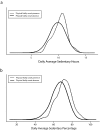Sedentary Behavior as a Risk Factor for Physical Frailty Independent of Moderate Activity: Results From the Osteoarthritis Initiative
- PMID: 25973826
- PMCID: PMC4463377
- DOI: 10.2105/AJPH.2014.302540
Sedentary Behavior as a Risk Factor for Physical Frailty Independent of Moderate Activity: Results From the Osteoarthritis Initiative
Abstract
Objectives: This prospective longitudinal study investigated the association between baseline objectively measured sedentary time and 2-year onset of physical frailty.
Methods: We studied 1333 Osteoarthritis Initiative participants 55 to 83 years of age who were at risk for physical frailty, as assessed via low gait speed (< 0.6 m per second) or inability to perform a single chair stand. Baseline sedentary time was assessed through accelerometer monitoring. Hazard ratios (HRs) for physical frailty onset were estimated with discrete survival methods that controlled for moderate physical activity, sociodemographic characteristics, baseline gait and chair stand functioning, and health factors.
Results: The incidence of physical frailty in this high-risk group was 20.7 per 1000 person-years. Greater baseline sedentary time (adjusted HR = 1.36 per sedentary hour; 95% confidence interval [CI] = 1.02, 1.79) was significantly related to incident physical frailty after control for time spent in moderate-intensity activities and other covariates.
Conclusions: Our prospective data demonstrated a strong relationship between daily sedentary time and development of physical frailty distinct from insufficient moderate activity. Interventions that promote reductions in sedentary behaviors in addition to increases in physical activity may help decrease physical frailty onset.
Figures
Similar articles
-
Accelerometer-monitored sedentary behavior and observed physical function loss.Am J Public Health. 2015 Mar;105(3):560-6. doi: 10.2105/AJPH.2014.302270. Epub 2015 Jan 20. Am J Public Health. 2015. PMID: 25602883 Free PMC article.
-
Association between frailty and the combination of physical activity level and sedentary behavior in older adults.BMC Public Health. 2019 Jun 7;19(1):709. doi: 10.1186/s12889-019-7062-0. BMC Public Health. 2019. PMID: 31174515 Free PMC article.
-
The association between sedentary behaviour, moderate-vigorous physical activity and frailty in NHANES cohorts.Maturitas. 2015 Feb;80(2):187-91. doi: 10.1016/j.maturitas.2014.11.010. Epub 2014 Nov 25. Maturitas. 2015. PMID: 25542406
-
The impact of physical activity and sedentary behaviors on frailty levels.Mech Ageing Dev. 2019 Jun;180:29-41. doi: 10.1016/j.mad.2019.03.004. Epub 2019 Mar 26. Mech Ageing Dev. 2019. PMID: 30926562 Review.
-
A systematic review of the association between sedentary behaviors with frailty.Exp Gerontol. 2018 Dec;114:1-12. doi: 10.1016/j.exger.2018.10.010. Epub 2018 Oct 22. Exp Gerontol. 2018. PMID: 30355522
Cited by
-
Actigraphy features for predicting mobility disability in older adults.Physiol Meas. 2016 Oct;37(10):1813-1833. doi: 10.1088/0967-3334/37/10/1813. Epub 2016 Sep 21. Physiol Meas. 2016. PMID: 27653966 Free PMC article.
-
Sex differences in the associations of accelerometer-determined physical activity with physical and cognitive function in older adults living in long-term care.Front Public Health. 2024 Nov 11;12:1446286. doi: 10.3389/fpubh.2024.1446286. eCollection 2024. Front Public Health. 2024. PMID: 39588160 Free PMC article. Clinical Trial.
-
Task Performance and Meta-Cognitive Outcomes When Using Activity Workstations and Traditional Desks.Front Psychol. 2016 Jun 21;7:957. doi: 10.3389/fpsyg.2016.00957. eCollection 2016. Front Psychol. 2016. PMID: 27445921 Free PMC article.
-
Time Spent in Sedentary Behaviour as Discriminant Criterion for Frailty in Older Adults.Int J Environ Res Public Health. 2018 Jun 26;15(7):1336. doi: 10.3390/ijerph15071336. Int J Environ Res Public Health. 2018. PMID: 29949848 Free PMC article.
-
Reducing sedentary time using an innovative mHealth intervention among patients with total knee replacement: Rationale and study protocol.Contemp Clin Trials Commun. 2021 Jun 18;22:100810. doi: 10.1016/j.conctc.2021.100810. eCollection 2021 Jun. Contemp Clin Trials Commun. 2021. PMID: 34195473 Free PMC article.
References
-
- He W, Sengupta M, Velkoff VA, DeBarros KA. 65+ in the United States: 2005. Available at: http://www.census.gov/prod/2006pubs/p23-209.pdf. Accessed February 10, 2015.
-
- Fried LP, Tangen CM, Walston J et al. Frailty in older adults: evidence for a phenotype. J Gerontol A Biol Sci Med Sci. 2001;56(3):M146–M156. - PubMed
-
- Ferrucci L, Guralnik JM, Studenski S et al. Designing randomized, controlled trials aimed at preventing or delaying functional decline and disability in frail, older persons: a consensus report. J Am Geriatr Soc. 2004;52(4):625–634. - PubMed
Publication types
MeSH terms
Grants and funding
LinkOut - more resources
Full Text Sources
Medical


